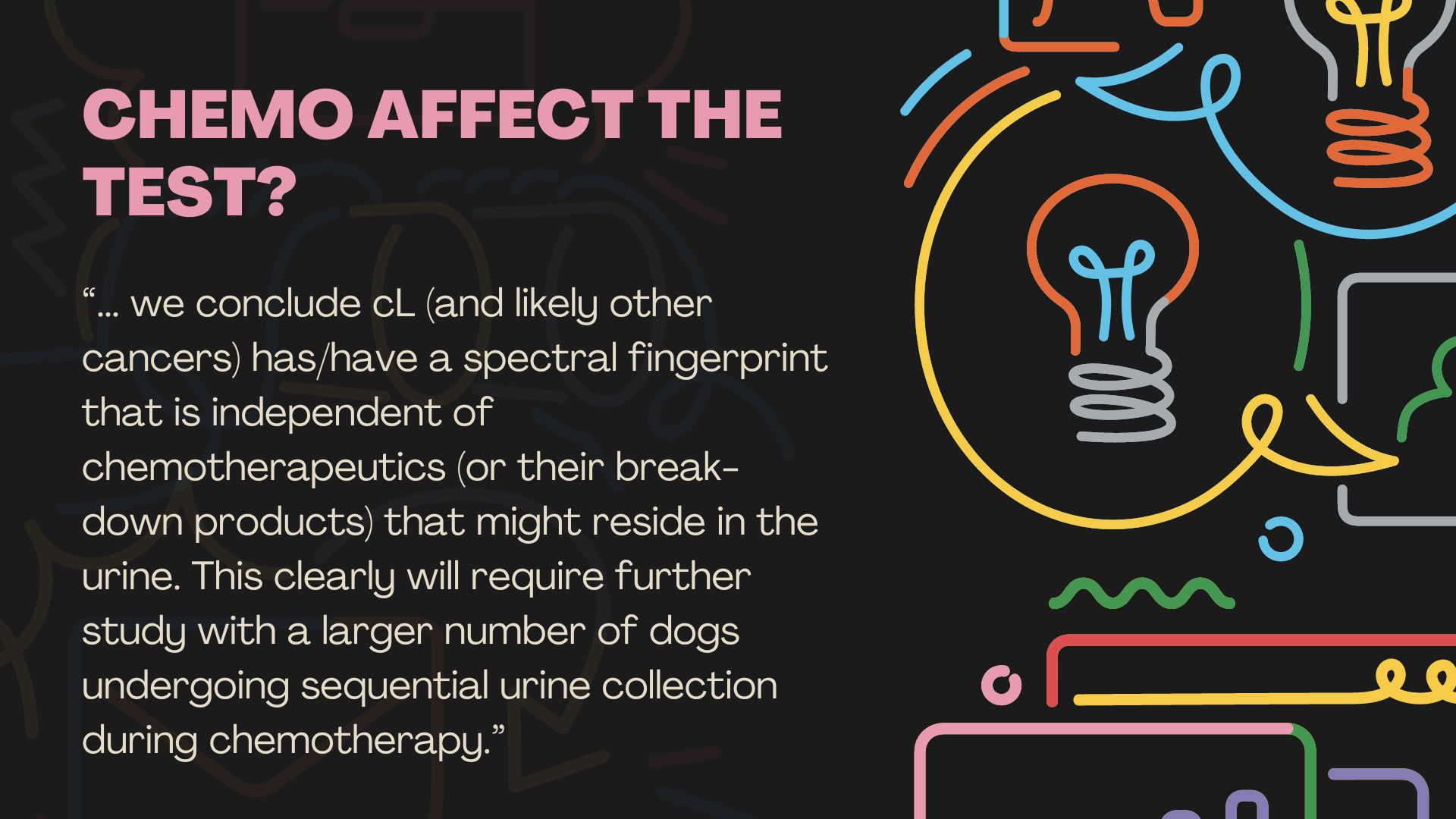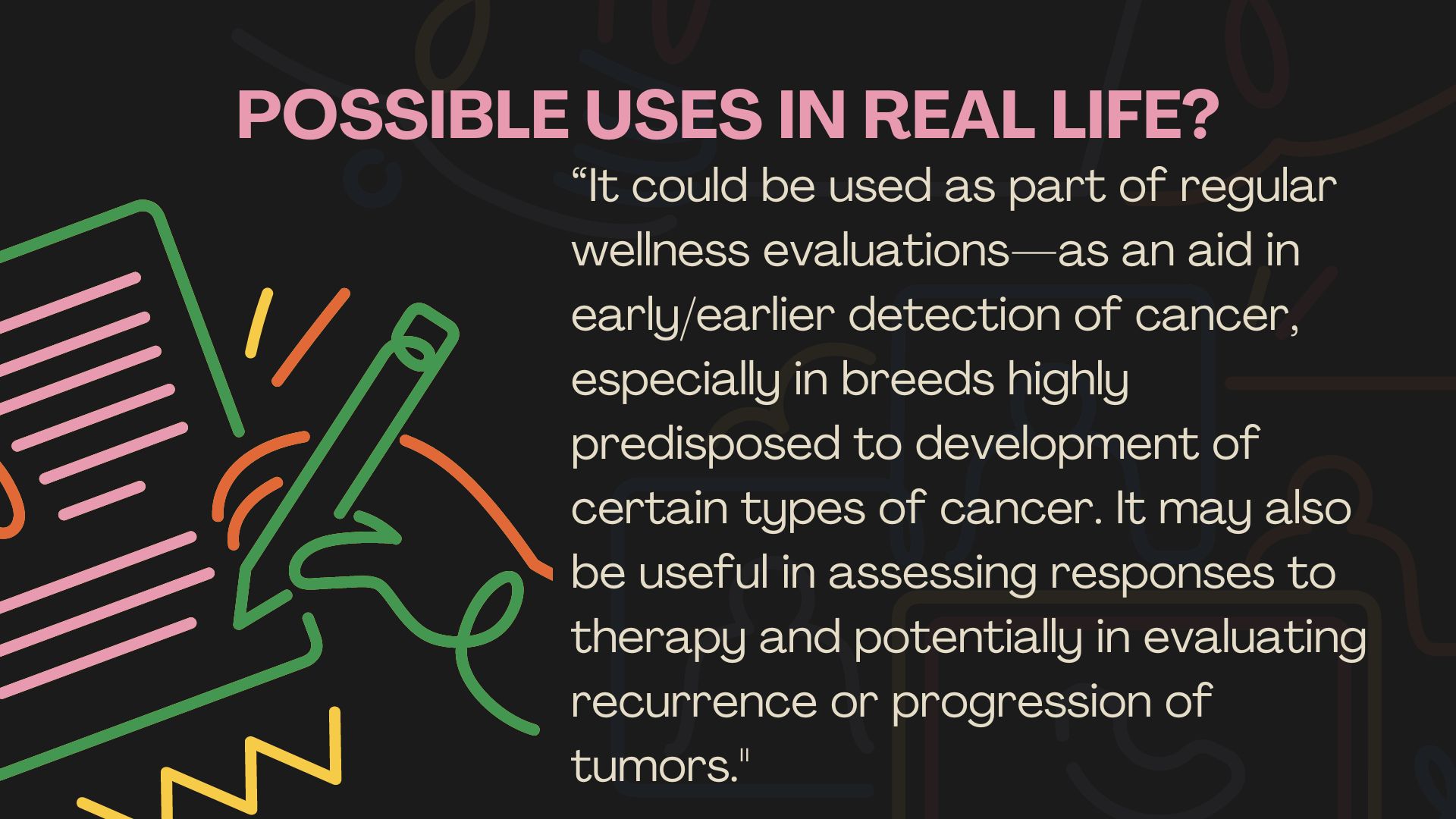I don't pretend to understand the complexities of Raman molecular urinalysis, but a study published in February 2024 looks at its use in detecting 4 common types of dog cancers, including lymphoma, urothelial carcinoma, osteosarcoma, and mast cell tumors. The idea that a quick in-office urine test might find cancer signatures is pretty exciting, so let's see what the researchers found.
Study Basics for Detecting Dog Cancers Via Urinalysis
A total of 292 dogs enrolled in the study through the Veterinary Teaching Hospital in Blacksburg, Virginia, as well as through the Animal Cancer Care and Research Center in Roanoke, Virginia, and some affiliated referral veterinarians. Of the 205 dogs included for analysis:
- 89 dogs got categorized as clinically healthy (with no signs or history of cancer)
- 100 dogs had been diagnosed with one of the 4 cancers -- lymphoma (53), urothelial carcinoma (18), osteosarcoma (12), and mast cell tumors (17)
- 16 of the dogs had been diagnosed with a non-cancerous urinary tract or renal disease
Researchers collected the urine samples via either mid-stream "free catch" or cystocentesis (withdrawn via a needle).
The Hypotheses
The paper outlines these 4 hypothesis or questions the researchers hoped to answer:
- "Can Raman spectroscopy detect differences in the urine metabolomes of dogs with cancer from healthy dogs or those with other non-neoplastic urinary tract disease?
- Can Raman spectroscopy of canine urine be used to distinguish between canine lymphoma (cL), urothelial carcinoma (UC), osteosarcoma (OS), and mast cell tumors (MCT)?
- Does the presence of chemotherapeutic agents impair or influence the urine screen?
- Can Raman spectroscopy of canine urine be used to identify the presence of non-neoplastic urinary tract disease?"
The authors make this caution: "It is important to note that the urine screening test described here is intended to supplement established gold-standard testing methods, physical exams, and treatment methods."
Results Overview for Detecting Dog Cancers Via (Fancy) Urinalysis
Apparently, it takes less than 5 minutes (with the correct equipment) to to assess each urine specimen. Also, it looks for spectral signatures from many molecules, rather than a single biomarker. That's kind of neat. Also, now is probably a good time to note that of the study's 11 authors 2 of them co-founded the company Rametrix™ Technologies (which created the tech and test, I believe) and another 1 worked for the company at the time of the study.
Can the fancy urinalysis detect differences between healthy dogs, dogs with common dog cancers, and dogs with other non-cancerous urinary or kidney issues? Short answer: Yes
Can the test distinguish between the different types of dog cancers studied? Again. Yep. The test finds variations in the spectra signatures from the fancy urinalysis. See the chart below:
- cL means canine lymphoma.
- UC means urothelial carcinoma.
- OS means osteosarcoma.
- MCT means mast cell tumor.
- UT disease means urinary tract/renal disease.
I suggest you read the study yourself and look at the accuracy, sensitivity, and specificity details if you really want to dog into the results. Keep reading / scrolling to see the study's authors own conclusions.
Does the presence of chemotherapeutic agents impair or influence the urine screen? It does not appear so in this initial study. The authors write, "Furthermore, spectral plots (see Supplementary Figure S1) appear nearly identical for the cL Chemo and cL No Chemo groups. Because of this, we conclude cL (and likely other cancers) has/have a spectral fingerprint that is independent of chemotherapeutics (or their break-down products) that might reside in the urine. This clearly will require further study with a larger number of dogs undergoing sequential urine collection during chemotherapy."
Can Raman spectroscopy of canine urine be used to identify the presence of non-neoplastic urinary tract disease? Not as much as cancer. The study's authors write, "... the screen for a cancer fingerprint produced better overall metrics than that for a non-neoplastic urinary tract disease given the dataset analyzed."
Conclusions Overview for Detecting Dog Cancers Via (Fancy) Urinalysis
This quote comes from the paper's abstract: "The procedure identified a spectral fingerprint for cancer in canine urine, resulting in a urine screening test with 92.7% overall accuracy for a cancer vs. cancer-free designation. The urine screen performed with 94.0% sensitivity, 90.5% specificity, 94.5% positive predictive value (PPV), 89.6% negative predictive value (NPV), 9.9 positive likelihood ratio (LR+), and 0.067 negative likelihood ratio (LR-). Raman bands responsible for discerning cancer were extracted from the analysis and biomolecular associations were obtained. The urine screen was more effective in distinguishing urothelial carcinoma from the other cancers..."
How We Might Use These Results?
The authors say, "It could be used as part of regular wellness evaluations—as an aid in early/earlier detection of cancer, especially in breeds highly predisposed to development of certain types of cancer. It may also be useful in assessing responses to therapy and potentially in evaluating recurrence or progression of tumors."
My Thoughts?
I was bummed that the dreaded hemangiosarcoma wasn't one of the dog cancers considered in this study. I was also disappointed that it's particularly good at finding the urinary cancer and not quite as good as the others. That said, if the test became routinely available at a reasonable cost, I might consider it for my dogs as they get older. How about you?










0 comments